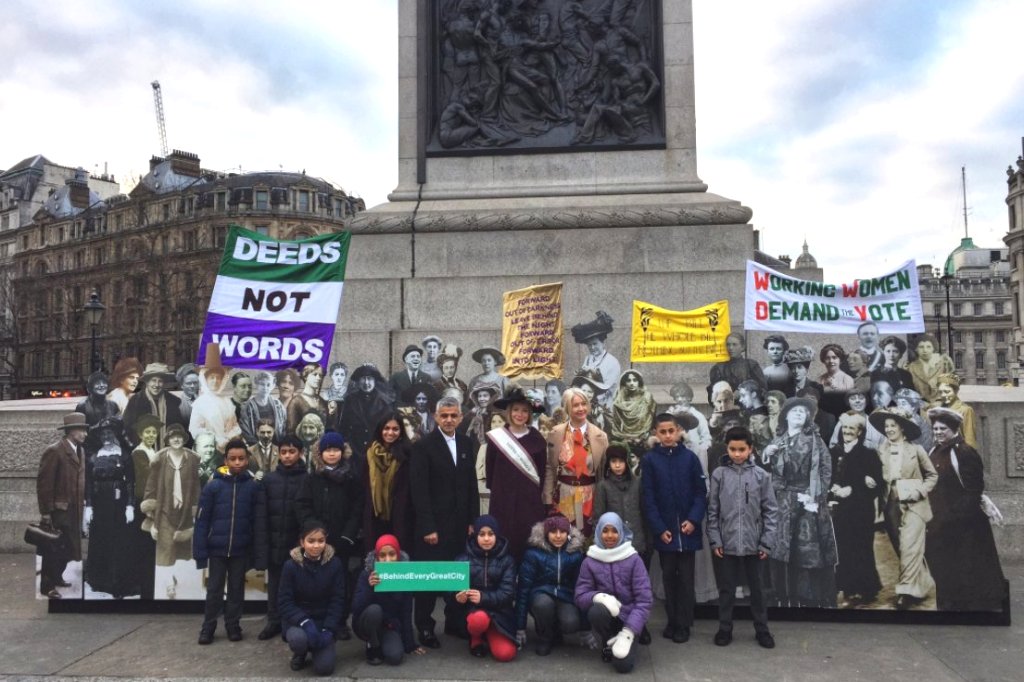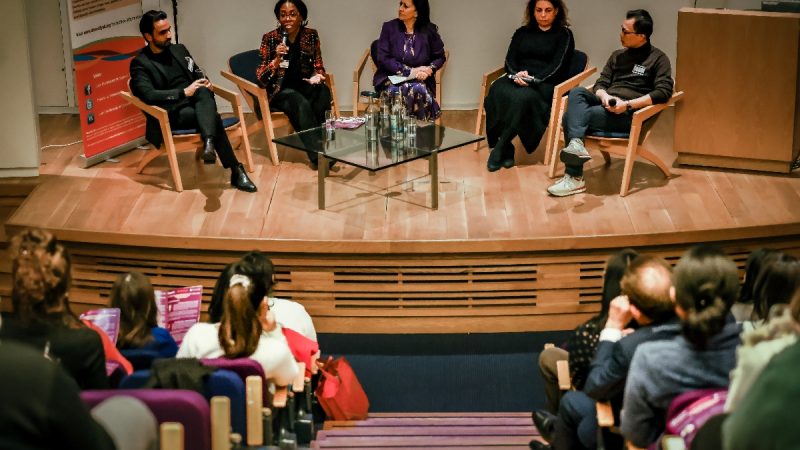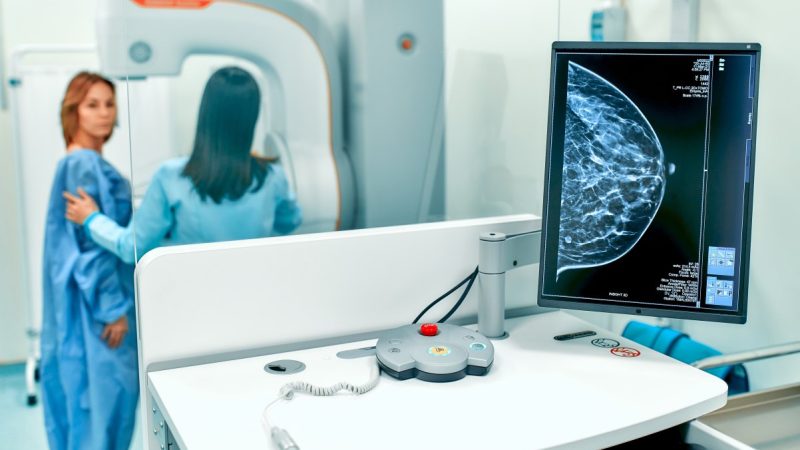Mayor marks centenary of women’s suffrage

The Mayor of London, Sadiq Khan, today (6th February 2018) revealed that artist Gillian Wearing’s Millicent Fawcett statue is set to feature names and portraits of women and men who were central to the suffrage movement. He was speaking at a specially-commissioned exhibition, featuring life-sized images of women and men on the plinth of the statue, in Trafalgar Square.
Later this spring, the statue of suffragist leader Millicent Fawcett in Parliament Square will be unveiled, the first-ever monument to a woman to stand within the central London location. On the centenary of the 1918 Representation of the People Act (6 February), a landmark victory which gave the first women the right to vote, Sadiq Khan revealed the names of the 59 women and men who will feature on the plinth of the statue. They were all people who dedicated themselves to women’s suffrage and, through their campaigning, helped secure the vote.
Make a Stand exhibition
To celebrate and highlight the contribution made by the women and men featured on the statue, a specially-commissioned exhibition is taking place in Trafalgar Square today to mark the centenary of the 1918 Representation of the People Act. The exhibition titled ‘Make a Stand’ features life-sized images of men and women included on the plinth of the statue, with images sourced from the Museum of London, LSE, the National Portrait Gallery, the Women’s Library and from other archives and private collections.
The list was compiled by a group of historians, specialists in Women’s History and Suffragette history, the artist Gillian Wearing OBE and a curator from the 14-18 NOW programme with the Mayor’s Office. The names are representative of the geographic, economic and cultural spread of people who made women's suffrage a possibility after many years of campaigning.
Alongside the photographic figures there will be handmade cloth banners featuring iconic slogans of the campaign for the vote, such as ‘deeds not words’. The figures are set against the backdrop of Trafalgar Square, which 100 years ago was an important location for many of the rallies and marches that took place in the struggle to secure the right to vote.
The plinth of the historic statue will include well-known figures like the Pankhursts and Emily Wilding Davison as well as many unsung heroes including:
Lydia Becker, who was President of the NUWSS prior to Millicent Fawcett and campaigned for the voting rights of unmarried women and widows.
Ada Nield Chew, a working-class factory worker who promoted women’s trade unions and was one of the first Clarion Van speakers.
Henrietta Franklin, who was an education reformer and leader of the Jewish League for Woman Suffrage.
Edith How-Martyn, who campaigned for birth control and was a key figure in Suffragette Fellowship .
Lolita Roy, who was President of the London Indian Union from 1908.
Louisa Garett Anderson, a medical pioneer who founded the Women’s Hospital Corps.
Rosa May Billinghurst, a suffragette who was part of Christabel Pankhurst’s campaign in the 1918 election. She survived polio and campaigned for the Women’s Social and Political Union in a modified tricycle or on crutches.
Annie Kenney, a working-class mill worker who became a leading figure in the Women's Social and Political Union, campaigning in Bristol.
Sophia Duleep Singh, a member of the Women's Social and Political Union who campaigned for votes for women. She led a 400-strong demonstration to parliament together with Mrs Pankhurst, and she was the daughter of Maharaja Duleep Singh, the last Maharaja of the Sikh Empire.
Jessie Craigen, a working-class speaker. Despite researcher’s best efforts an image of her could not be found, so she is represented as a name without a picture on the statue plinth. Perhaps during this process of highlighting her story, a photo of her will come to light.
The plinth will also feature some of the men who campaigned for women’s suffrage, including Laurence Housman, the founding member of the Men’s League for Women’s Suffrage, and George Lansbury, one of the most well-known male supporters of women’s suffrage in Britain – he helped form the East London Federation of Suffragettes which his wife Minnie Lansbury also joined.
The Mayor of London, Sadiq Khan, said: “6 February marks an important moment in the history of our city - 100 years since the 1918 Representation of the People Act was passed which gave the first women the right to vote. As part of our #BehindEveryGreatCity campaign I’m really proud to unveil the women and men whose names and portraits will be etched on the plinth of the Millicent Fawcett statue – which will be the first statue of a woman in Parliament Square.
“The plinth will include well-known figures of the suffrage movement as well as those that are less well known. This is an important step in ensuring we highlight the contribution to gender equality made by these 59 women and men.”
Deputy Mayor for Culture and the Creative Industries, Justine Simons, OBE, said: “One hundred years ago today, women who campaigned for the right to vote secured a landmark victory against a system that denied them their fundamental democratic rights. To mark this historic achievement, I am delighted we can announce the names of the 59 women and men who will feature on Gillian Wearing’s statue of Millicent Fawcett. These people fought tirelessly for women’s right to vote and while some of the names are well known, others have been too often overlooked. Through Gillian’s work we will shine a light on their role and inspire Londoners in our continued fight for gender equality.
“The campaign for gender equality has achieved so much over the past 100 years but it is clear there is still a long way to go. We want to honour this moment by bringing these key figures out of the archives in to Trafalgar Square, on the same spot where major speeches took place 100 years ago. This year, together with organisations and industries across London, we will spread the message that Behind Every Great City are women and girls from all walks of life, contributing hugely to the success of our capital.”
Artist Gillian Wearing OBE said: “I am delighted to reveal the names of the women and men who will feature on the plinth of Millicent Fawcett's statue. These were all incredible people and by honouring them in Parliament Square, I believe they will continue to inspire generations to come.”
The statue is being created by Turner Prize-winning artist Gillian Wearing OBE after being commissioned by the Mayor with 14-18 NOW, Firstsite and Inivia. This follows Caroline Criado-Perez’s successful campaign for a statue of a woman in Parliament Square. The statue is being funded through the Government’s national centenary fund.
#BehindEveryGreatCity campaign
It is being unveiled as part of the Mayor’s major #BehindEveryGreatCity campaign across 2018 to celebrate the role London played in the movement and to drive gender equality across the capital. The campaign champions the fact that it is the achievements and contributions of women, from all walks of life, which make cities like London great. The campaign slogan #BehindEveryGreatCity is a deliberate play on the feminist slogan used globally in the 60s and 70s, ‘Behind every great man stands a great woman’ and highlights that women instead power great cities.
Throughout 2018, the campaign will highlight London’s story in the history of the women’s suffrage and equality movement, celebrating significant milestones and achievements while identifying and tackling barriers to women fulfilling their potential today. A range of events and celebrations will take place throughout the year, such as at The Museum of London, the home of the world’s largest Suffragette collection.
Key facts and dates – 1918 Representation of the People Act
1918 - The Representation of the People Act is passed on 6 February giving women the vote provided they are aged over 30 and either they, or their husband, meet a property qualification
1918 - The Parliament (Qualification of Women) Act is passed on 21 November allowing women to stand for Parliament
1918 - Women vote in a general election for the first time on 14 December with 8.5 million women eligible
1928 - The Equal Franchise Act is passed giving women equal voting rights with men. All women aged over 21 can now vote in elections. Fifteen million women are eligible.
1929 - On 30 May women aged between 21 and 29 vote for the first time. This general election is sometimes referred to as the Flapper Election.




